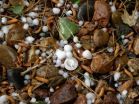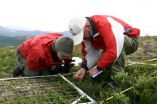(Press-News.org) An article in the forthcoming issue of the Journal of Integrated Pest Management (JIPM) refutes claims by Greenpeace Germany that the western bean cutworm (WBC), Striacosta albicosta (Smith), is "a new plant pest" that was "caused by genetically engineered corn." The Greenpeace Germany report, which was written by author Christoph Then of Testbiotech, offers a "surprisingly simplistic conclusion" regarding the spread of western bean cutworm over the last decade, according to the JIPM authors.
In "Genetically Engineered Bt Corn and Range Expansion of the Western Bean Cutworm (Lepidoptera: Noctuidae) in the United States: A Response to Greenpeace Germany," corresponding author William Hutchison, professor and chair of the University of Minnesota Department of Entomology, and his co-authors maintain that the Greenpeace report fails to consider broader ecological and agronomic factors which explain why the WBC's range has expanded. These additional factors include insect biology, synchrony of insect and corn phenology, reduced insecticide use, increases in conservation tillage, soil type, glyphosate-resistant crops, insect genetics, insect pathogens, pre-existing insect population densities, and climate change.
The JIPM authors focus on several discrepancies of fact and interpretation in the Greenpeace document, beginning with its title, "Agro-biotechnology: New plant pest caused by genetically engineered corn. The spread of the western bean cutworm causes massive damage in the U.S."
Despite the Greenpeace claim, the WBC is neither "new" nor has it caused "massive damage" recently. The WBC was originally collected in Arizona in the 1880s and was considered an economic pest of beans and corn as early as 1915. Over the last decade its range has expanded, but documentation of economically damaging infestations has been relatively limited.
The Greenpeace claim that the WBC has historically "been confined to very limited regions and did not cause any major problems in maize crops" is also untrue, according to the authors. Farmers in Nebraska reported major problems as early as 1962, and instead of being "confined to very limited regions," the WBC was documented throughout the western Great Plains from Mexico to Alberta, where it was found in the mid 1950s, despite the Greenpeace claim that it was found in Canada for the first time as recently as 2009.
According to the authors, "a curious theme throughout the Greenpeace Germany report, is that Then (2010) ignored the possibility of other influences on western bean cutworm range expansion, including several ecological and agronomic factors." For example, the increasing use of conservation tillage since the mid-1990s favors the survival rate of WBC larvae because less deep plowing minimizes mortality to insect pests that overwinter in the soil. Another possible reason is the reduction or elimination of insecticide applications, which has occurred with increased use of Bt corn over the past decade, likely resulting in increased survival of the WBC. Other possibilities for the WBC range expansion, such as climate change, were also ignored by Greenpeace and Testbiotech.
Out of concern that "potential misinterpretation of selected quotes" in the Greenpeace report may lead to confusion among future regulatory decision makers, the authors go on to give specific responses to other claims in the report.
INFORMATION:
These responses, and the full JIPM article, can be downloaded at http://www.entsoc.org/PDF/2012/JIPM-Greenpeace.pdf.
The Journal of Integrated Pest Management is a peer-reviewed, open-access, extension journal covering the field of integrated pest management. It is published by the Entomological Society of America, the largest organization in the world serving the professional and scientific needs of entomologists and people in related disciplines.
Media Inquiries should be directed to:
Dr. William D. Hutchison, PhD
University of Minnesota
(612) 624-1299; hutch002@umn.edu
Dr. Thomas E. Hunt
University of Nebraska
(402) 584-3863; thunt2@unl.edu
Dr. Gary L. Hein
University of Nebraska-Lincoln
(402) 472-3345; ghein1@unl.edu
END
A biology lab at Washington University has just cracked the structure and function of a protein that plays a key role in the life of a parasite that killed 655,000 people in 2010.
The protein is an enzyme that Plasmodium falciparum, the protozoan that causes the most lethal form of malaria, uses to make cell membrane.
The protozoan cannot survive without this enzyme, but even though the enzyme has many lookalikes in other organisms, people do not make it. Together these characteristics make the enzyme an ideal target for new antimalarial drugs.
The research was published ...
Climate change is having a more profound effect on alpine vegetation than at first anticipated, according to a study carried out by an international group of researchers and published in Nature Climate Change. The first ever pan-European study of changing mountain vegetation has found that some alpine meadows could disappear within the next few decades.
Led by researchers from the Austrian Academy of Sciences and the University of Vienna, biologists from 13 different countries in Europe analysed 867 vegetation samples from 60 different summits sited in all major European ...
We've all seen the story in the news before. Whether it's the death of a physically fit high school athlete at football training camp in August, or of an elderly woman gardening in the middle of the day in July, heat stroke is a serious, life-threatening condition for which there is no treatment beyond submersion in ice water or the application of ice packs to cool the body to a normal temperature.
But, in a new study published today in the journal Nature Medicine, scientists discovered what they believe is one of the first drugs to combat heat stroke. AICAR – an experimental ...
Summertime hail could all but disappear from the eastern flank of Colorado's Rocky Mountains by 2070, according to a new modeling study by scientists from NOAA and several other institutions.
Less hail damage could be good news for gardeners and farmers, said Kelly Mahoney, Ph.D., lead author of the study and a postdoctoral scientist at NOAA's Earth System Research Laboratory in Boulder, Colo. But a shift from hail to rain can also mean more runoff, which could raise the risk of flash floods, she said.
"In this region of elevated terrain, hail may lessen the risk of ...
A team of scientists, led by researchers at the University of California, San Diego School of Medicine and Zacharon Pharmaceuticals, have developed a simple, reliable test for identifying biomarkers for mucopolysaccharidoses (MPS), a group of inherited metabolic disorders that are currently diagnosed in patients only after symptoms have become serious and the damage possibly irreversible.
The findings will be published online January 8 in the journal Nature Chemical Biology.
MPS is caused by the absence or malfunctioning of a lysosomal enzyme required to break down ...
Much of what living cells do is carried out by "molecular machines" – physical complexes of specialized proteins working together to carry out some biological function. How the minute steps of evolution produced these constructions has long puzzled scientists, and provided a favorite target for creationists.
In a study published early online on Sunday, January 8, in Nature, a team of scientists from the University of Chicago and the University of Oregon demonstrate how just a few small, high-probability mutations increased the complexity of a molecular machine more than ...
CHAMPAIGN, Ill. — Those making land use decisions to reduce the harmful effects of climate change have focused almost exclusively on greenhouse gases – analyzing, for example, how much carbon dioxide is released when a forest is cleared to grow crops. A new study in Nature Climate Change aims to present a more complete picture – to incorporate other characteristics of ecosystems that also influence climate.
"We know that forests store a lot of carbon and clearing a forest releases carbon dioxide into the atmosphere and contributes to climate change," said University of ...
In a report published in Nature Physics, they used graphene, the world's thinnest and strongest material, and made it magnetic.
Graphene is a sheet of carbon atoms arranged in a chicken wire structure. In its pristine state, it exhibits no signs of the conventional magnetism usually associated with such materials as iron or nickel.
Demonstrating its remarkable properties won Manchester researchers the Nobel Prize in Physics in 2010.
This latest research led by Dr Irina Grigorieva and Professor Sir Andre Geim (one of the Nobel prize recipients) could prove crucial ...
The decade from 2000 to 2009 was the warmest since global climate has been measured, and while localized studies have shown evidence of changes in mountain plant communities that reflect this warming trend, no study has yet taken a continental-scale view of the situation – until now.
With the publication of "Continent-wide response of mountain vegetation to climate change," scheduled for Advance Online Publication (AOP) in Nature Climate Change on 8 January, researchers from 13 countries report clear and statistically significant evidence of a continent-wide warming effect ...
Founder of EditCopyProof, Charlon Bobo, today announced the official launch of a new website featuring products and services specifically developed for evolutionary entrepreneurs. As one of only a few businesses worldwide addressing the specific needs of this market, Bobo is the only copywriter.
Affectionately known as the "conscious copywriter," Bobo enjoys the success of a worldwide clientele and a loyal following of evolutionary entrepreneurs; a quickly-emerging market. The term is a relatively new one, coming onto the business scene within the past year.
Evolutionary ...




